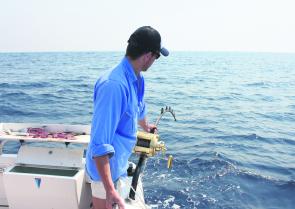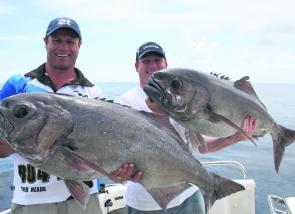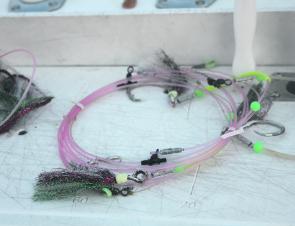The 4kg sinker was lowered over first and then the trace with the three baited 16/0 circle hooks followed. The lever on the big Daiwa electric reel was pulled back and the rig plummeted towards the bottom, almost half a kilometre below.
The braid stopped coming off the reel and the angler engaged the reel, wound the slack out of the line and four sets of eyes focused on the rod tip.
They didn’t have to wait long.
The tip started to bounce and the big electric reel was shifted to retrieve. The bow in the line caused by the current soon vanished and the rod started to load up. The 80lb bent-butt chair rod was clearly taking strain as the fish far below started to fight.
At one stage we were actually losing line as the fish pulled 130lb braid against a drag set at 36kg. The reel continued to winch with the braid crackling as it settled on the large spool.
Scott supported the rod to take the load off the rod holder and we checked the safety clips again, just in case something gave way under the strain. Fifteen minutes later, we saw a cluster of large bubbles hit to the surface and shortly after we had colour.
Two large blue-eye trevalla broke the surface a short distance from the boat and were manhandled aboard.
These prime table fish were around 15kg and 25kg – this was what deepwater fishing with electric reels is all about.
It may sound as if this scenario was almost too easy. You would probably be right in some ways and on board our charter boat RU4REEL it can seem this way at times, but this is a technique that has taken us two years to refine.
To be able to consistently catch these delicacies of the deep you must work out the finer details and put the pieces of the puzzle together.
We have been through many trials and tribulations since we started fishing for them and had numerous fishless days. But, as with any other fishing technique, once you have worked out how to catch these deep-dwellers, it can be very rewarding and make the hard yards worthwhile.
These deep species are basically just other forms of reef fish, with the same characteristics as snapper or pearl perch caught in 50m to 100m.
First, you must be able to see them. On our charter boat we very seldom drop on a reef unless we can see fish marking up on the sounder.
The same goes for the deep stuff, where we are talking in excess of 350m. The majority of the fishing is around 400m to 450m.
We run a Geonav Sounder/GPS combo unit with a 2KW transducer. This unit can still see the bottom at 1000m and works exceptionally well in the depths where we do most of our deep drops.
The big sounder is the most important part of the equation. Without it we would not be able to catch many of these fish at all.
Many of the smaller boats tend to use sounders with 1KW transducers and although these units are really good down to about 300m, they really struggle once you go deeper than this.
A 1KW transducer set up right will show the bottom reasonably well but will struggle to show fish. Over flat ground they work a lot better than in sharply shelving areas but the 2KW is definitely a must if you want to be able to mark fish past 300m.
The key to consistently catching these fish is to sound the likely area that you intend fishing before you have a drop. If you see life then you will get the bites.
Fortunately, most of the areas where we deep drop are around our blue marlin trolling grounds, so we are always watching the ocean floor for signs of life while towing lures for blues.
Blue marlin are also often found around structure like seamounts, ledges and steep drop-offs – all good fish holding structures for bottom fish.
If we are trolling an area and notice a showing on or close to the bottom, we mark this on the GPS and often edit the waypoint by calling it something like ‘life’ and then return for further investigation at a later date, or once we have had enough of trolling.
If there are fish there you will usually get a bite almost immediately. If there is nothing there, move on until you see more life on the bottom.
It is a good idea to watch the thickness of the sonar bottom line. A thicker bottom will mean the harder sort of bottom that our target fish prefer. Ledges and ridges are hot spots, whereas massive peaks or drop-offs don’t seem to hold as many fish.
It may be that the fish struggle to hold on these steep ledges or that the current may be harsher, making holding in these areas more difficult.
You have found a likely-looking bit of structure and you are marking fish on it. How do you get your baits down to the fish?
As with other reef fish, the deepies will generally hold on the better part of the reef so a random drop just won’t work, especially when your rig may take several minutes to get down.
The idea is to do a ‘dummy drift’ first to work out how the boat will drift and at what speed. This will depend on current and wind.
Your drift can be anything up to 2.5 knots, so you can easily travel a half a mile in one drift by the time you have dropped down and hopefully brought up your fish.
Once you have worked out your drift, it is then a case of heading up your drift line far enough above where you marked the fish to allow your rig enough time to get to the bottom. This may take a couple of attempts and as you get used to the amount of time your rig takes to get down, it will become easier to work out.
Your rig is down. On our first drift in a new area we often winch up a bit of line to lift the sinker off the bottom to stop it from snagging.
If the fish are there and on the chew, they should bite almost immediately. If they are not on the chew you may need to allow the sinker to bounce the bottom or even let it sit on the bottom if there isn’t much current.
This can be a bit tricky because the reef that many of these fish call home is usually quite rocky and your rig can get snagged fairly quickly if you let it sit too long.
The bite may not be the massive hit you might expect from such large fish. It may in fact have been a big hit down there on the bottom but the huge amount of line out and the belly caused by current may just result in a few bumps at your rod tip.
Engage the reel and support the rod as the line tensions up. The rod should load up significantly under the strain and the fish will start to fight back.
We run two Daiwa Marine Power electric reels for our deep fishing and their power is utterly amazing.
Their lower gear ratio handles the heavy weights and you will need to be quite vigilant while the reel is winching to stop it if anything happens. If you don’t, the reel will simply keep winding until you stop it.
To guard against simply winching the terminal tackle through the rod guides, they have an automatic stop incorporated into the line counter. Once your trace gets close to the rod tip, it will stop and leave you a few metres to wind in manually.
It doesn’t really matter what you use but we do have a preference towards oily fish like tuna, simply because we believe it provides a bit more attractant down deep.
We have caught quality deep-dwellers on mullet, pilchards, squid, tuna and nannygai at some stage or another.
The real key is to put the bait in front of the fish instead of hoping that they will come to you. Once you have worked this out and you can consistently find them, the rest will come easily.
Facts
THE RIG
Our main deep-drop species two off NSW-Queensland border are blue-eye trevalla and bass groper. We do get the odd gemfish and bar cod but the bar cod seem to prefer water from around 150m to 300m.
Once you get down around 400m to 500m the fish get bigger and the species numbers decrease. These fish have big mouths and are very powerful so your trace needs to be up to the task.
We use 300lb mono for the main trace line and hooks, and 16/0 Mustad Circle hooks, which are super-strong and can handle the punishment. We can legally run only three hooks like this in NSW so we keep all our rigs standard with three hooks whether we are fishing in Queensland or NSW. And you wouldn’t really want to have more than three of these fish on a line at once, anyway!
We use 80lb mono for the sinker trace, which allows it to break away if you we snag the bottom. Weights can range from 2kg to 6kg, depending on current. We generally go as heavy as we can because it tends to get down quicker and keep the baits close to the bottom.
The components of these rigs may sound fairly substantial but we have been through a few trials and quickly found out that if you do hook three large deepwater fish on a rig, they pretty much smash up the trace or bend the hooks open if the hardware isn’t up to scratch.

Hooked up to a couple of monsters from the deep can put a lot of strain on the tackle, even when it’s a 37kg bent-butt broomstick. Supporting the rod is often a good idea.

Deon Nourse with a cracking blue-eye caught aboard RU4REEL Charters.

Bass groper are another deep water species that grows large yet is extremely tasty on the plate.

Andrew Ettingshausen and Tim Morgan with a double of big blue-eye on Ru4Reel

Having your deep-drop traces rigged up and ready to go makes life a lot easier. This way you are sure that everything is rigged correctly and if you hook up big-time your rig won’t let you down.

All the requirements to make up a deep drop rig. A roll of 300lb mono, some crimps and swivels to suit, 16/0 Mustad circle hooks and a roll of glow tubing.

Being able to differentiate between fish and structure is important when deep dropping. The fish marking up on this ledge show as the green patches above the bottom.





